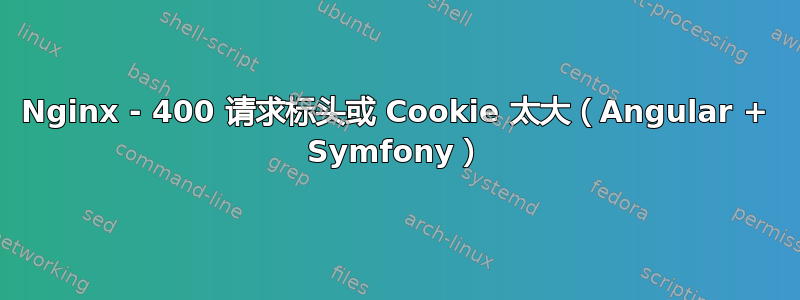
我在同一台服务器上有两个项目:
- Symfony 3 API(api.example.com)
- 一个使用上述 API 的 Angular 5 webapp(www.example.com)
两者都在同一台服务器上,每个服务器都有一个 Nginx 配置文件。两者都支持 HTTPS,并且在我的服务器上运行良好:Angular 显示其主页,我可以在 api.example.com/doc 上看到 API 的文档,因此问题出在我想从我的 webapp 调用 API 的端点时。
在 Angular 应用上,用户可以通过 Google OAuth 登录,如果用户成功登录,API 会向 Web 应用提供 Bearer Token。
问题是 OAuth 身份验证之后,对 API 的第一次请求失败并出现以下错误:
400 Bad Request
Request Header Or Cookie Too Large
我的 JWT 令牌如下所示:
Bearer eyJhbGciOiJSUzI1NiJ9.eyJyb2xlcyI6WyJST0xFX1VTRVIiXSwidXNlcm5hbWUiOiIxMDU1MTc2OTEwNjQzODA2MDQ0NDgiLCJleHAiOjE1MTE1NzkyMDgsImlhdCI6MTUxMDkxMjU0Mn0.EQR-8za7LdvsdGmOrBrJnH5QZrkzObop7B_9_KsSjPAYTHV_3BwQEOgz-AJcbffNvBgGlVphsUgVzU2npp7AclrrZ1EScjjDmx7mKY4vBCRr__fL8WhMVjLEApavaGVTwG-AJBRzDOGA8DVpa9rC_Bd_ixtZtKMaZrJsqm5OjmqexbWd5GM9FJr8uO6bZnS4Xk2WnfNTIFWgkKdqMT0F4zkZMHFXJmV8BRb0JG1-ktx2Y7IK3Npk3MD02pMS2QdIikjPSUbfXaQzqVKhbpH_N-WyEgBjdRCKPMjBlYVm9uhM0rkaPDpZemawaqB0Wm_bWrDPUnlNz4xQ18xkXu-mWvXi0jNTP7ezMqDAZyxCY37S4wrUb-jBz_e_7klEsUfrUTPid63K6wBn00bQPyqyPHybQgurcKFDRPMgT0W2nfnxjssBmz_pBpCL5pJFPlAiAonq8DZxELWQW9oSLNbOxy3kF2macl2tNDY1sl88uftbIzD1hF2Hrh-xqRsgDUei-KdcxetJ_CwdYPlw48lUbeFUmYp1llX5YB3WBkMVMzDCh14fACiN0d0AHqRKiQb6dpAFcidS8NWdQb1B7ytM586r6NIjWcL9SboTemOIMu884IszccUowpd9R-eScmxQCbKKxKtkktIGxKkSz9BuGJU25oW0C1wNbzdkonlOYDQ
我没有在错误日志中看到有关此问题的任何信息。我猜这是由于我的 Nginx 配置引起的,但我不知道是来自 webapp 还是 API Nginx 配置。
这是我的 Webapp Nginx 配置文件:
server {
listen 80;
server_name www.example.com example.com;
return 301 https://www.example.com$request_uri;
}
server {
listen 443 ssl;
server_name example.com;
return 301 https://www.example.com$request_uri;
ssl_certificate /etc/letsencrypt/live/example.com/fullchain.pem;
ssl_certificate_key /etc/letsencrypt/live/example.com/privkey.pem;
ssl_protocols TLSv1 TLSv1.1 TLSv1.2;
ssl_prefer_server_ciphers on;
ssl_ciphers 'EECDH+AESGCM:EDH+AESGCM:AES256+EECDH:AES256+EDH';
}
# Change this depending on environment
upstream api {
server api.example.com:443;
}
server {
listen 443 ssl;
server_name www.example.com;
root /home/example/public_html/example-front-prod/dist;
index index.html;
location = /index.html {
internal;
add_header Cache-Control no-cache;
error_page 404 = @ng-index;
}
location / {
error_page 404 = @ng-index;
}
location @ng-index {
internal;
rewrite ^.*$ /index.html last;
}
location /assets {
add_header X-Assets custom-header;
}
location ^~ /favicon.ico {
log_not_found off;
access_log off;
}
location ^~ /robots.txt {
allow all;
log_not_found off;
access_log off;
}
location ^~ /.well-known/ {
log_not_found off;
}
ssl_certificate /etc/letsencrypt/live/example.com/fullchain.pem;
ssl_certificate_key /etc/letsencrypt/live/example.com/privkey.pem;
ssl_protocols TLSv1 TLSv1.1 TLSv1.2;
ssl_prefer_server_ciphers on;
ssl_ciphers 'EECDH+AESGCM:EDH+AESGCM:AES256+EECDH:AES256+EDH';
large_client_header_buffers 4 512k;
# /api will server your proxied API that is running on same machine different port
# or another machine. So you can protect your API endpoint not get hit by public directly
location /api {
proxy_pass https://api;
proxy_http_version 1.1;
proxy_set_header Upgrade $http_upgrade;
proxy_set_header Connection 'upgrade';
proxy_set_header Host $host;
proxy_cache_bypass $http_upgrade;
proxy_set_header X-Real-IP $remote_addr;
proxy_set_header X-Forwarded-For $proxy_add_x_forwarded_for;
proxy_ssl_certificate /etc/letsencrypt/live/api.example.com/fullchain.pem;
proxy_ssl_certificate_key /etc/letsencrypt/live/api.example.com/privkey.pem;
}
#Static File Caching. All static files with the following extension will be cached for 1 day
location ~* .(jpg|jpeg|png|gif|ico|css|js)$ {
expires 1d;
}
sendfile on;
##
# Gzip Settings
##
gzip on;
gzip_http_version 1.1;
gzip_disable "MSIE [1-6]\.";
gzip_min_length 1100;
gzip_vary on;
gzip_proxied expired no-cache no-store private auth;
gzip_types text/plain text/css application/json application/javascript application/x-javascript text/xml application/xml application/xml+rss text/javascript;
gzip_comp_level 9;
access_log /var/log/nginx/www.example.access.log;
error_log /var/log/nginx/www.example.error.log;
}
最后,这是 Symfony API Nginx 配置文件:
server {
server_name api.example.com;
return 301 https://api.example.com$request_uri;
}
server {
listen 443 ssl;
server_name api.example.com;
root /home/example/api/symfony/web;
location / {
# try to serve file directly, fallback to app.php
try_files $uri /app.php$is_args$args;
}
# PROD
location ~ ^/app\.php(/|$) {
fastcgi_pass unix:/run/php/php7.1-fpm.sock;
fastcgi_split_path_info ^(.+\.php)(/.*)$;
include fastcgi_params;
# When you are using symlinks to link the document root to the
# current version of your application, you should pass the real
# application path instead of the path to the symlink to PHP
# FPM.
# Otherwise, PHP's OPcache may not properly detect changes to
# your PHP files (see https://github.com/zendtech/ZendOptimizerPlus/issues/126
# for more information).
fastcgi_param SCRIPT_FILENAME $realpath_root$fastcgi_script_name;
fastcgi_param DOCUMENT_ROOT $realpath_root;
# Prevents URIs that include the front controller. This will 404:
# http://domain.tld/app.php/some-path
# Remove the internal directive to allow URIs like this
internal;
}
# return 404 for all other php files not matching the front controller
# this prevents access to other php files you don't want to be accessible.
location ~ \.php$ {
return 404;
}
location ^~ /.well-known/ {
log_not_found off;
}
# pass the PHP scripts to FastCGI server listening on 127.0.0.1:9000
location ~ ^/(app|app_dev)\.php(/|$) {
fastcgi_pass unix:/run/php/php7.1-fpm.sock;
fastcgi_split_path_info ^(.+\.php)(/.*)$;
include fastcgi_params;
fastcgi_param SCRIPT_FILENAME $document_root$fastcgi_script_name;
fastcgi_param HTTPS true;
}
client_body_buffer_size 32k;
client_header_buffer_size 8k;
large_client_header_buffers 8 64k;
ssl_certificate /etc/letsencrypt/live/api.example.com/fullchain.pem;
ssl_certificate_key /etc/letsencrypt/live/api.example.com/privkey.pem;
ssl_protocols TLSv1 TLSv1.1 TLSv1.2;
ssl_prefer_server_ciphers on;
ssl_ciphers 'EECDH+AESGCM:EDH+AESGCM:AES256+EECDH:AES256+EDH';
error_log /var/log/nginx/example-api.error.log;
access_log /var/log/nginx/example-api.access.log;
}
我希望large_client_header_buffers它能帮助我解决我的问题但它并没有改变任何事情。
我该如何解决这个错误?


